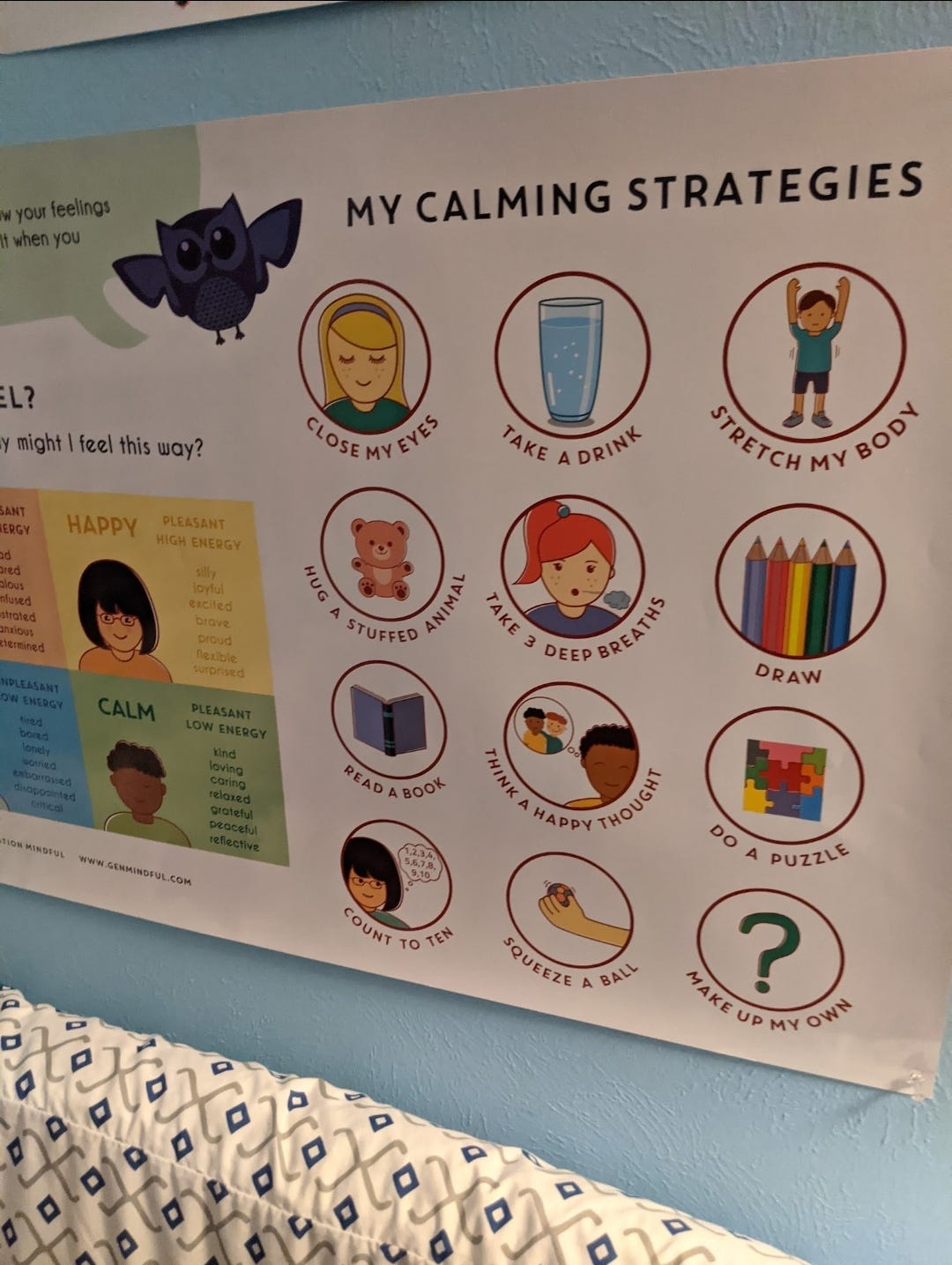"You must learn to let go. Release the stress. You were never in control anyway."
— Steve Maraboli

Recently, I’ve started writing and publishing these newsletters again after a long silence.
My stress levels caused me to take an extended break, again.
It's really hard living with complex PTSD with dissociation, plus several other issues that affect my energy output.
However, as I usually do, I keep pulling myself up by the bootstraps and going on with life.
Although, those bootstraps are getting quite worn and frayed! (Can you relate??)
So, when I saw this article recently about what happens when your stress exceeds your tolerance by Psychology Today, I knew I needed to share it.
Here are the key points:
We all have a “window of tolerance,” which is an optimal arousal zone.
Stress and other difficult emotions can bring us to the edge of that window.
Being mindful of our "inner landscape" and practicing certain exercises can return us to a state of calm. (emphasis added mine)
Based on my experiences and conversations with others, it’s clear we are all extremely stressed, especially since 2020.
Many of us are beyond any normal sense of stress. We’re on a never-ending hamster wheel of exhaustion!
(But keep reading, because I share my top three stress-reducing strategies further in this newsletter.)
Many of us are beyond any normal sense of stress.
We’re on a never-ending hamster wheel of exhaustion!
The Psychology Today article talks about what happens when you reach your window of stress level and even exceed it, what to look for, and how to manage the situation so you can get back to an even baseline level.
I especially related to what it says about what happens when that level is reached or exceeded.
Several paragraphs stood out to me like these:
“It is important to remember that our window of tolerance can change from day to day, or even moment to moment; for instance, feeling tired, hungry, or sick often narrows our window.
Also, bear in mind that stressful situations affect people differently, so don’t beat yourself up comparing yourself.”
And these…
”If you’ve experienced this kind of dysregulation, or observed it in someone else, perhaps you’ll recognize how your (or their) response to things—like sudden noises, a remark, dropping something as simple as a pen—become more rigid, intense, or chaotic and harder to endure.
Overreacting to harmless triggers or false alarms is a hallmark of being out of your window of tolerance.”
After spending four years helping to raise my twin grandsons with special needs full-time, I was in such a hypervigilant, overextended, stressful state that I was diagnosed with Complex PTSD with Dissociation, Major Depressive Disorder, and Generalized Anxiety.
It took me three full years, and a lot of therapy and self-healing using many of the tips and techniques mentioned in this article, to get back to a baseline level of calm.
Earlier this summer, I found myself in a heightened stressful state again due to a few minor family emergencies.
Everything piled on top of the other and before I knew it, I was shaking with anxiety, yelling at my spouse, and completely overwhelmed.
I quickly realized I was out of control and utilized a few stress-relieving techniques such as:
Breathwork
Removing myself from the stressor (aka trigger)
Journaling and/or talking with someone about it (preferably a therapist or counselor)
Let’s dive deeper into these techniques.
Breathwork
Nothing, and I mean NOTHING, will return you to a calmer state quicker than deep breathing.
Breath is life.
Multiple studies have shown that breathwork can help reduce stress and improve mental health:
Meta-analysis
A 2023 meta-analysis of 12 randomized controlled trials (RCTs) found that breathwork interventions were associated with lower stress levels than controls. The study also found that slow-paced breathing interventions were more effective when taught individually than in groups.
reference links: Breathing to Reduce Stress | How Breathing Can Help Reduce Stress
Slow breathing
A 12-week study found that regular slow breathing practices significantly reduced psychological stress, but not physiological stress. The study also found that exhaling more than inhaling, compared to exhaling the same amount as inhaling, led to further reductions in both psychological and physiological stress. (emphasis added mine)
reference links: Effect of breathwork on stress | Slow breathing for reducing stress: The effect of extending exhale | Review and meta-analysis suggests breathwork may be effective for improving stress and mental health
Other studies have shown that breathing exercises can help people think more clearly, reduce anxiety, and promote positive emotions. Breath control is also used in practices like yoga, tai chi, and some forms of meditation.

When I become overwhelmed and anxious, I go to my quiet space, sit down cross-legged, and do the breathing technique mentioned above.
STRESS REDUCTION STRATEGY #1:
Breathe in for a count of three, hold the breath at the top for a count of four, then slowly and evenly exhale to the count of seven. Another way is called box breathing, using counts of four.
Another example of this is called pranayama breathing, or alternate nostril breathing typically practiced in yoga, and is another favorite of mine.
Here’s a helpful video from one of my favorite yogis, Yoga with Adriene on YouTube:
Removing myself from the stressor
Removing yourself from a stress trigger is an effective strategy to manage and reduce stress.
You gain immediate relief from the stress, mental clarity, and perspective. It also allows you to process your emotions, preventing impulsive reactions that might escalate the situation.
When I was raising small children, I was teaching them about emotional control. And there were many times when I needed it myself.
I found about calming spaces and emotion coaching with a Time-In Tool Kit from Generation Mindful and created one for my grandsons, who I was helping raise at the time.
One day, when I was utterly depleted and unable to stop crying, my grandsons led me to their calm-down corner with fluffy pillows, stuffed animals, and soft light. They asked me to point to my emotions on the posters tacked to the wall and snuggled with me.
Right then I knew calm down corners weren’t just for kids. We adults deserve them too. This brings me to my next strategy.
STRESS REDUCTION STRATEGY #2
Create a space for you to escape and calm down.
It doesn’t have to be kid-themed, although if you create one for your kids there’s no shame in using it.
Now, that I’m an empty nester, mine is my “she cave/office.”
I have a soft light, a large yoga mat, comfy blanket folded up to sit and breathe deeply. My coloring book, colors, the current book I’m reading, and my journal are nearby.
Speaking of journals, that’s my final strategy for reducing stress.
Journaling/Talking about it
I have had a journal ever since I was a kid. Every year my mom bought me a new one for my birthday, usually cat-themed because I love cats.
Journaling is a fantastic way to manage stress, offering a safe space to unload your thoughts and emotions.
By putting pen to paper, you can gain clarity, process your feelings, and find solutions to problems that seem overwhelming.
Plus, it's a simple, cost-free practice that can become a cherished part of your daily routine, helping you feel more grounded and in control.
If you don’t like to write, talking with a therapist or counselor helps too.
Journaling is a fantastic way to manage stress, offering a safe space to unload your thoughts and emotions.
STRESS REDUCTION STRATEGY #3
Buy a journal and write! It’s really that simple.
But, if you’re like me, you might like to have a pretty, spiral-bound, college-ruled journal for the easiest writing.
(And don’t forget to get a pen that writes easily and comfortably! My favorite is BIC Velocity 1.6 in blue!)
I usually find my journals at dollar stores or on Amazon for around $5-$10.
Like I said earlier, if you don’t like writing, then talk!
Voice record a personal journal, talk with a trusted friend, or regularly with your therapist.
I get free therapy through my insurance because they partner with MD Live. Check with your insurance company.
You might be surprised to find out you have the same or similar free or low-cost access to a therapist!
CONCLUSION
If you're a stressed-out parent and caregiver, and you recognize yourself or someone in your life from this article who has reached (or exceeded) their window limit of stress, I highly recommend utilizing the information and tips in this newsletter.
As a reminder, here are the top 3 stress-reducing tips I use:
Deep breathing exercises like box breathing or pranayama.
Removing myself from the stressful situation and calming down in a quiet space.
Journaling and/or talking about it with a trusted friend or therapist.
And reach out to me for help! I've been there and understand living and coping with high amounts of stress.
We can have a conversation, complimentary to you, to see if we would be a good fit to work together to help you reduce and manage your stress.
Book your session and let’s get started!
Your friend,
Dawn-Renée
*Portions of this article were generated with the help of AI technology.






